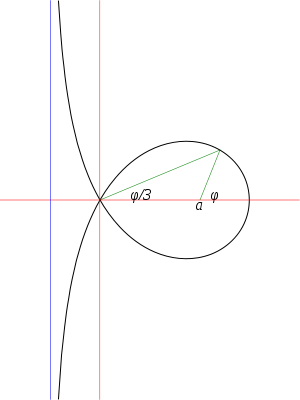Trisectrix of Maclaurin

In geometry, the trisectrix of Maclaurin is a cubic plane curve notable for its trisectrix property, meaning it can be used to trisect an angle. It can be defined as locus of the point of intersection of two lines, each rotating at a uniform rate about separate points, so that the ratio of the rates of rotation is 1:3 and the lines initially coincide with the line between the two points. A generalization of this construction is called a sectrix of Maclaurin. The curve is named after Colin Maclaurin who investigated the curve in 1742.
Equations
Let two lines rotate about the points and so that when the line rotating about has angle with the x axis, the rotating about has angle . Let be the point of intersection, then the angle formed by the lines at is . By the law of sines,
so the equation in polar coordinates is (up to translation and rotation)
- .
The curve is therefore a member of the Conchoid of de Sluze family.
In Cartesian coordinates the equation of this curve is
- .
If the origin is moved to (a, 0) then a derivation similar to that given above shows that the equation of the curve in polar coordinates becomes
making it an example of an epispiral.
The trisection property
Given an angle , draw a ray from whose angle with the -axis is . Draw a ray from the origin to the point where the first ray intersects the curve. Then, by the construction of the curve, the angle between the second ray and the -axis is
Notable points and features
The curve has an x-intercept at and a double point at the origin. The vertical line is an asymptote. The curve intersects the line x = a, or the point corresponding to the trisection of a right angle, at . As a nodal cubic, it is of genus zero.
Relationship to other curves
The trisectrix of Maclaurin can be defined from conic sections in three ways. Specifically:
- .
- It is cissoid of the circle
- and the line relative to the origin.
- .
In addition:
- The inverse with respect to the point is the Limaçon trisectrix.
- The trisectrix of Maclaurin is related to the Folium of Descartes by affine transformation.
References
- J. Dennis Lawrence (1972). A catalog of special plane curves. Dover Publications. pp. 36,95,104–106. ISBN 0-486-60288-5.
- Weisstein, Eric W. "Maclaurin Trisectrix". MathWorld.
- "Trisectrix of Maclaurin" at MacTutor's Famous Curves Index
- "Trisectrix of MacLaurin" on 2dcurves.com
- "Trisectrix of Maclaurin" at Visual Dictionary Of Special Plane Curves
- "Trisectrice de Maclaurin" at Encyclopédie des Formes Mathématiques Remarquables